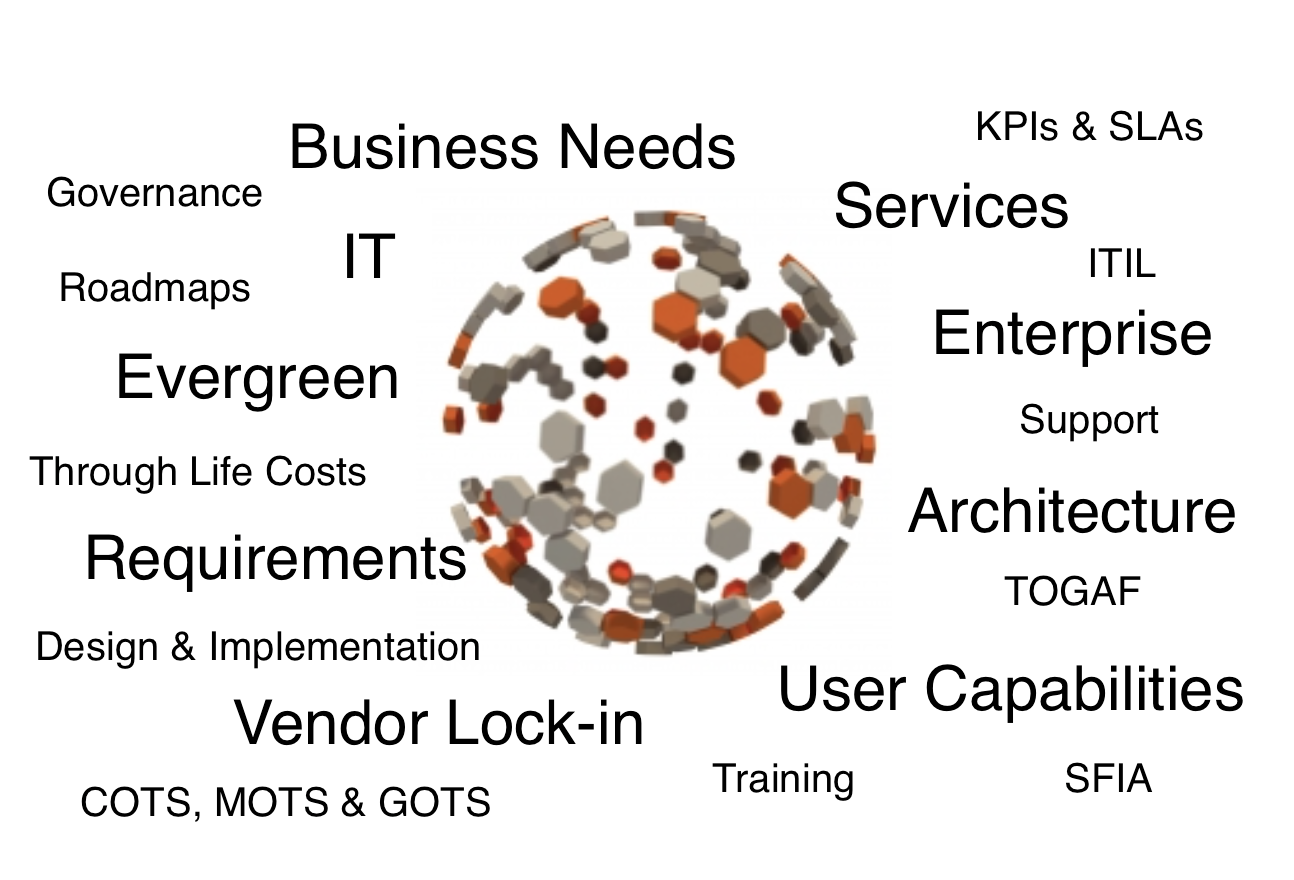
26/08/2017
Why do so many Government Initiatives & IT related projects fail?
August 2017
“There is no such thing as an IT project! There are only Business Projects and they implement, impact, change, interface and make use of the enabling power of IT, not led by IT, that must understand the true business need and deliver systems and processes to satisfy that need. With technology moving so fast, you should be able to swap in/out specific IT with minimal overall effects thus not being locked in any specific vendor solution, and provide you users with an intuitive and common look and feel to minimise training, support and running through life costs. This can only be achieved by detailed planning, architecture and critical thinking.”
- Doomed from the Start - If there is no appointed single person responsible for the delivery from the start then there is typically no figurehead, no importance attached to it, no incentives driven through and no performance management systems in place. When you add multiple stakeholders with different agendas into the mix, you have a toxic mix!
- Business Process Complexity - Government Departments bite off more than they can chew and can’t reduce the complexity of what they do. They lack clarity of what is needed, have poor communication practices, poor contracting and procurement processes and have little appreciate of coherence, best practice and learning from lessons already learnt (not invented here approach prevails throughout). Projects are not properly scoped in terms of costs, schedule, timescales, technical risks and design/delivery approaches, and are driven forward with a conspiracy of optimism rather than realism!
- Portfolio Management & Beyond - People think in terms of IT projects when they are in fact business change and new capability processes involving people, processes and products. The larger the project/programme, the more challenges that this brings and Government often by default assumes all the involved and emerging risks!
- Senior Leadership Skills Knowledge Gaps - A little knowledge can be a dangerous things. Don’t let business leaders make complex IT related decisions as they don’t often appreciate the fallout When your leadership think that agile means not doing the required critical thinking, planning, governance or documentation, you are in real trouble!
- Inability to stop Requirements Creep - If you don’t have the majority of the critical requirements in a stable state, you are doomed to an almost impossible spiral of re-work and never ending re-design. The problem is compounded when it is demanded by a senior stakeholder, doesn’t come with any additional resources, funding or time, which means something else that was planned now doesn’t get done (hopefully it is not any critical elements)!
- Governance and Risk Management - Ineffective governance, lack of accountability and responsibility, lack of timely decision making (people can get fired for making the wrong decisions, few people get fired for not making decisions), committee’s don’t have the required expertise, and it all boils down to loosing sight of what needs got be done!
- Missing and wrong analysis of the business needs - Focus on end user/customer requirements and failure to address how services and products need to be designed, delivered, supported, align to corporate policies, adhere to corporate procedures, the business skills needed, the backend analysis, management IPR, licences and changes!
- Needs change before implementation - The churn of people, sponsors, political priorities, business priorities, unwillingness to change requirements mid-flow, vendors bid low knowing delivery is not viable without further changes thus getting an opportunity to make additional profits, people don’t understand the need for change to help create the minimal viable product. Few organisations want to spend time or money on effective change management strategies!
- Over Ambitious Expectations - A ‘can-do’ mindset that exceeds the achievable capabilities of the organisation (available people, time and budgets) with everything else that is going on. The conspiracy of optimism is fuelled by stretched targets (often linked to performance incentives), ignorance of the ‘done done’ practice, the magic design dust that solves all know technical problems or changing personnel until you have the right ‘yes people’ in place!
- Delay after Delay - Can’t agree priorities, never able to start on schedule, conflicting objectives, over allocation of key critical staff, more complex supplier negotiations, unanticipated procurement lead times, high staff turnover leading to a lot of re-learning and no continuity of knowledge/experience, risk processes …. but not tangible mitigation actions developed!
- Lack of Top Customer Management Involvement - lack of customer skills, training or experience in the process and related planning, design, procurement or implementation processes caused huge problems and efforts being directed at inappropriate items!
- Bid/Contracts/Supplier Team Migration - The ‘A’ Team has won the bid and moved on, and now left the ‘B’ Team trying to salvage a doomed project, trying to implement unrealistic requirements or making concessions from promises made. It is always difficult when the accountable structures separate the requirements from the real needs to the end users!
- Contradictory Demands - This problem is compounded if there is no universally accepted taxonomy, list and definition of terms, lack of standardisation, methodologies differ, so an item can have many meanings, values and expectations differ widely between agencies, organisations or even departments!
- Lack of Critical Knowledge or Technical Expertise or Big Picture Understanding - When there is a lack of critical knowledge within the organisation and you are heavily dependent on temporary contractors with no sustainability plan to gain that knowledge internally, project success can just walk out the door at anytime. People still think they can defy the laws of physics, suspend the time-space continuum or fit a size 14 foot into a size 10 shoe through sheer directives coupled with a try harder speech and a continuous improvement programme!
- Committee Consensus - The larger the group of ‘intelligent’ people the more difficult is can be to reach a valid, workable and pragmatic solution. Watch for political manoeuvrings/agendas, the JFDI culture and the blame of the innocents, empire building and in-fighting, not want to question the prime directives, nay say the project sponsor or people just avoiding the elephant in the room all being potentially play-out at the same time!
- Processes come before Performance or People - When the process police start to dictate everything you do, you are destined to follow the mistakes of the old and not allowed to innovate a better future. Listen to your people that do the work because they are your best source of making it better, not an outside who has done it another way, in another organisation with a different culture!
- No Incentive To Succeed - When there is no penalties, nobody gets fired, less automation so everyone stays in a job, extra budget gets allocated next financial year and life goes on for everyone in a similar manner. Why wouldn’t you put your least capable, most bumbling and proven failure manager on the job? Private sector initiatives are driven by market forces and desire to maintain/increase market position among their competitors, no such motivation exists in the public sector!
- Contractor Conundrum - If we are paying contractors five times what we are on, why are we doing the work, just delegate it to them, nobody within government is accountable (they are all looking for their next job/pay rise) and blame is passed around like a hot potato!
- Too Many Initiatives - Focus is lost when there are a lot of competing initiatives all seeking the same small pool of expertise, so something has to give or some initiatives don’t get the support to resources they properly need to deliver!
- Managing the Legacy - Many projects are still maintaining legacy systems because there is no funding to update them. It is difficult to plan for, fund and backward implement evergreen systems if they are not architected in a modular manner, compounded by all the problems associated with data migration, data integrity and trying not to bring old rubbish data into the new systems!
- Personal ‘Pet’ Projects - Some projects are initiated by key people within the organisation, and it takes a brave individual (some may say they are committing career suicide) by even suggesting that a failing project should be stopped early and cheaply, or effort directed elsewhere!
- Staff Churn - Churn of sponsors and other key stakeholders between the concept stage and implementation stage is a major factor. Where the key people (i.e. typically 15% turnover or above on 3 year projects) are not in the job long enough to see the project through to completion and there is a lack of coherent succession planning then you have a problem!
- Tailoring the Message - Nobody wants to be associated with a failing project, so reports can often be adjusted to focus on the successes and underplay the risks/issues/concerns. Management often ignore the warning signs of failing projects, and information provided should be open, honest, not doctored for public viewing (Gateway Reviews) or used against individuals in future reviews or appraisals!
- Government Accounting Policy - If you don’t spend it in the financial year you loose it not just for this year but for next year, promotes behaviours like wild end of financial year purchases, focus on short-term initiatives rather than medium/long term opportunities and inability to move monies around to the required areas without complex processes being involved (if at all).
Potential Solutions
- Start Small - Fund prototypes, get industry to provide alpha versions to test, become more agile in your approaches to determining the art of the possible and identify risk areas.
- Transfer Risk - Break larger projects down into smaller phased ones that only proceed once the subsequent one has been delivered to the required outcomes. Use the initial projects to gather data to help inform your KPIs/SLAs for future phases.
- Don’t try and re-invent the market - The market has evolved based on darwinian principles of the survival of the fittest and cheapest (e.g. VHS Video) and not necessarily on the best (e.g. BETAMAX Video). Government needs to follow what already exists out there in the marketplace, respect IPR, talk market language to get what they want, understand what systems work well together and what systems don’t, be careful of chasing the early adopter product philosophy and make sure they understand the limitations of the systems available.
- Become more transparent - Share successes and failures between Government Departments and Projects, and involve potential vendors/suppliers in early discussions to help shape the outcomes more thoroughly.
- Attract Better Talent - All the improvements can only be delivered by people, so Government will need to lure the best brains, top talented developers and successful entrepreneurs from industry to make it all happen by building stronger relationships with academia and industry.
References
1. http://www.gartner.com/newsroo...
